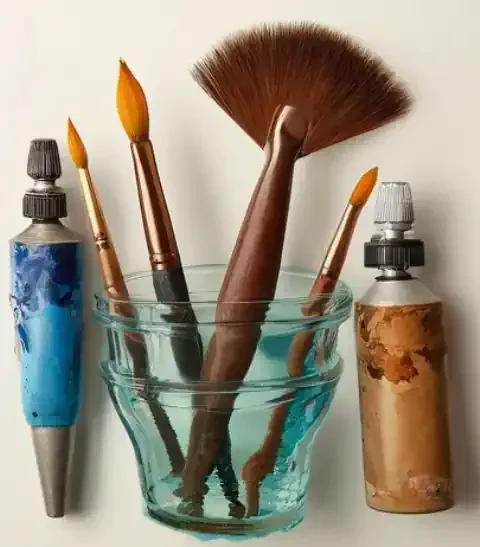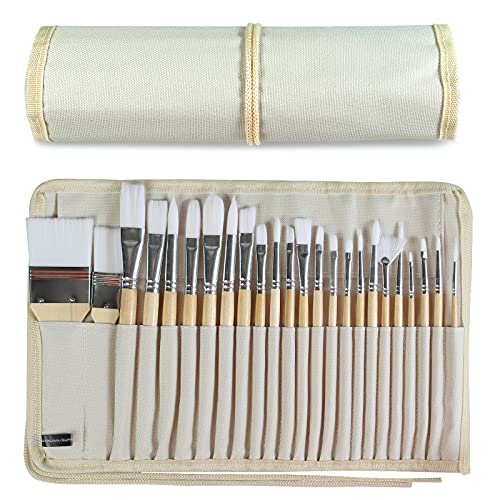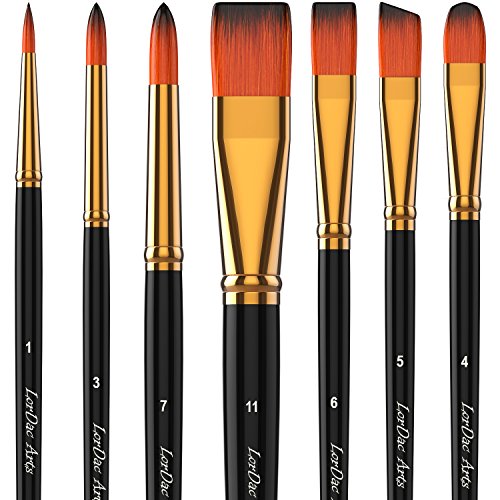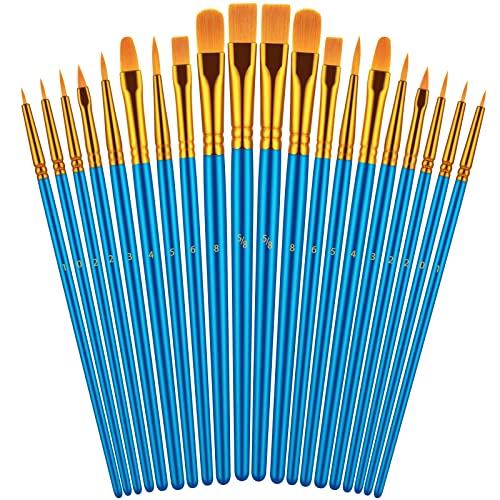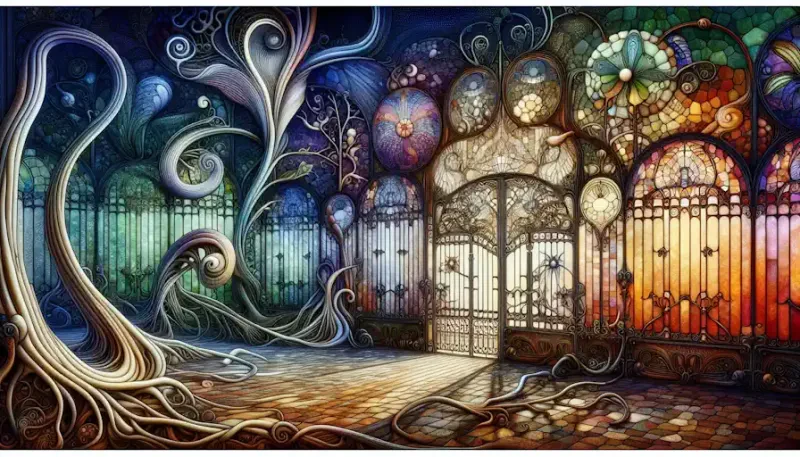Introduction: The Art of Choosing the Right Paint Brush
Choosing the right paint brush is a skill that goes beyond merely applying paint to a surface. It's about understanding how different brushes interact with various mediums, creating textures, and achieving desired effects. This guide will equip you with the knowledge to select the perfect brushes for your artistic journey, regardless of your experience level or preferred style.
Why Paint Brushes Matter: Beyond Just Applying Paint
Paint brushes are an extension of your artistic expression. They influence the texture, flow, and overall appearance of your artwork. A well-chosen brush can elevate your technique, enabling you to create delicate lines, bold strokes, subtle gradients, and intricate details.
Understanding the Anatomy of a Paint Brush
Before diving into specific brush types, let's familiarize ourselves with the key parts of a paint brush:
Bristles: The hairs of the brush, which can be natural or synthetic.
Ferrule: The metal band that holds the bristles to the handle.
Crimp: The part of the ferrule that is crimped to secure the bristles.
Handle: Typically made of wood or plastic, providing grip and control.
Understanding these components will help you assess brush quality and make informed decisions.
Natural vs. Synthetic Bristles: Key Differences and Uses
One of the most fundamental choices you'll face is between natural and synthetic bristles. Each type has distinct advantages and is better suited for specific mediums:
Natural Bristles: Derived from animal hair (e.g., sable, hog), natural bristles are known for their ability to hold a large amount of paint and create smooth blends. They are often preferred for oil and watercolor painting.
Synthetic Bristles: Made from nylon, polyester, or other synthetic materials, these bristles are more durable, easier to clean, and generally more affordable. They are a versatile choice for acrylics, heavy-body paints, and mixed media.
The choice between natural and synthetic often comes down to personal preference, budget, and the type of paint you're using.
A Quick Overview of Popular Brush Shapes
Brush shapes significantly influence the marks you can make. Here's a quick overview of some common shapes:
Round: Versatile for details, lines, and filling small areas.
Flat: Ideal for covering large areas and creating bold strokes.
Filbert: A combination of round and flat, offering blending and line work capabilities.
Bright: Short, stiff bristles for creating texture and impasto.
Fan: Soft bristles for blending and creating natural effects.
We'll explore these shapes in more detail later in this guide.
Matching Your Brush to Your Medium: Essential Considerations
Different paints have unique properties that necessitate specific brush characteristics. For instance:
Oil paint: Requires brushes with good paint-holding capacity and stiffness for blending.
Acrylic paint: Works well with synthetic bristles that can handle the paint's fast-drying nature.
Watercolor: Demands soft, absorbent bristles that hold ample water.
By understanding the relationship between brushes and mediums, you'll be able to select the ideal tools to bring your artistic vision to life.
Understanding Brush Shapes and Their Purposes
The shape of a paint brush plays a crucial role in determining the types of strokes and effects you can achieve. From fine details to broad washes, each brush shape has a unique purpose. Let's explore some of the most common shapes and their applications.
Round Brushes: Versatile Tools for Details and Lines
Round brushes are the workhorses of the art world. With their pointed tips and tapered bristles, they offer exceptional control for creating fine lines, intricate details, and delicate strokes. They are equally adept at filling in small areas and creating smooth transitions between colors.
Flat Brushes: Covering Large Areas and Bold Strokes
Flat brushes are characterized by their square or rectangular shape and straight bristles. They excel at covering large areas quickly and efficiently, making them ideal for backgrounds, washes, and bold strokes. By varying the pressure and angle of the brush, you can create a range of textures and effects.
Filbert Brushes: The Best of Both Worlds – Blending and Lines
Filbert brushes combine the best features of round and flat brushes. Their rounded tips and flat edges allow for both blending and line work, making them a versatile choice for a variety of techniques. They are particularly well-suited for creating soft edges, organic shapes, and subtle gradients.
Bright Brushes: Short, Stiff Bristles for Texture and Impasto
Bright brushes have short, stiff bristles that are perfect for creating texture and impasto effects. They hold a lot of paint and can be used to apply thick layers of color, creating raised surfaces and expressive brushstrokes. Bright brushes are often used in oil painting to achieve a three-dimensional quality.
Fan Brushes: Soft Blending and Creating Natural Effects
Fan brushes feature a spread-out array of soft bristles, resembling a fan. They are primarily used for blending colors and creating natural effects, such as foliage, clouds, and smoke. Fan brushes are also excellent for creating smooth gradients and feathering edges.
Angle Brushes: Precise Strokes and Calligraphy
Angle brushes have slanted bristles that allow for precise control and angled strokes. They are commonly used for creating fine lines, calligraphy, and detailed work. Angle brushes are also useful for painting corners and edges, as their shape allows for easy access to tight spaces.
Mop Brushes: Large Washes and Covering Expansive Areas
Mop brushes are large, round brushes with a high capacity for holding paint. They are primarily used for creating large washes, filling in backgrounds, and covering expansive areas with color. Mop brushes are also excellent for applying glazes and creating smooth transitions between colors.
By understanding the unique properties of each brush shape, you can select the right tools to achieve your desired artistic effects. Experimenting with different shapes and sizes will expand your creative possibilities and allow you to discover new techniques.
Natural Bristles: Pros, Cons, and Best Applications
Natural bristles have been the go-to choice for artists for centuries, prized for their unique qualities that enhance various painting techniques. Let's look into the world of natural bristles, exploring their types, benefits, drawbacks, and ideal applications.
Types of Natural Bristles: Sable, Hog, Ox, and More
Natural bristles are derived from various animal hairs, each with distinct characteristics:
Sable: Considered the gold standard for natural brushes, sable bristles (usually from the Kolinsky sable) are incredibly soft, fine, and possess exceptional spring and point retention. They are often used for delicate watercolor washes and detailed oil painting.
Hog: Hog bristles are stiffer and more durable than sable, making them well-suited for oil painting and other mediums that require a firmer touch. They hold a good amount of paint and create expressive brushstrokes.
Ox: Ox hair bristles are similar to hog bristles but slightly softer. They are a good compromise for artists who desire the control of hog bristles with a touch more flexibility.
Squirrel: Squirrel hair is incredibly soft and absorbent, making it ideal for watercolor washes and glazing techniques. It's known for its ability to hold a large amount of water.
Goat: Goat hair is often used for softer watercolor brushes or for creating textured effects in other mediums.
The Benefits of Natural Hair: Holding More Paint, Soft Blends
Natural bristles offer several advantages over synthetic bristles:
Superior Paint-Holding Capacity: Due to their porous nature, natural bristles can absorb and hold a significant amount of paint, reducing the need for frequent reloading. This is particularly beneficial for techniques like blending and glazing.
Softness and Flexibility: Natural bristles, especially sable, offer unparalleled softness and flexibility, allowing for smooth, controlled strokes and delicate details. They are perfect for creating subtle gradients and soft edges.
Spring and Snap: Natural bristles have excellent spring and snap, meaning they quickly return to their original shape after each stroke. This property ensures consistent brushstrokes and precise control.
Drawbacks of Natural Bristles: Cost, Care, and Allergies
While natural bristles offer many benefits, they also come with some drawbacks:
Cost: High-quality natural hair brushes, especially sable, can be quite expensive. This can be a barrier for beginners or budget-conscious artists.
Care and Maintenance: Natural bristles require more meticulous care than synthetic bristles. They must be cleaned thoroughly after each use and conditioned to maintain their shape and performance.
Allergies: Some individuals may be allergic to animal hair, making natural bristle brushes unsuitable for them.
Ideal Uses for Natural Brushes: Oil Painting, Watercolor Washes
Natural brushes excel in specific applications, particularly:
Oil Painting: Their ability to hold a large amount of paint, create smooth blends, and produce expressive brushstrokes makes them ideal for oil painting techniques.
Watercolor Washes: Soft, absorbent natural bristles are perfect for creating delicate watercolor washes and layering colors.
Glazing: The ability to hold and distribute a thin layer of paint evenly makes natural brushes well-suited for glazing techniques.
By carefully considering the pros and cons of natural bristles, you can determine if they align with your artistic needs and budget.
Synthetic Bristles: Modern Alternatives with Unique Advantages
The development of synthetic bristles revolutionized the art world, providing artists with affordable, durable, and versatile alternatives to natural hair brushes. Let's explore the world of synthetic bristles, their composition, advantages, ideal applications, and even their growing popularity in the realm of watercolor.
Synthetic Bristle Materials: Nylon, Polyester, and Blends
Synthetic bristles are typically made from nylon, polyester, or a blend of both. These materials are engineered to mimic the properties of natural hair, offering varying degrees of stiffness, flexibility, and absorbency.
Nylon: Nylon bristles are known for their durability and resilience. They hold their shape well and are resistant to fraying, making them ideal for heavy-body paints and textured techniques.
Polyester: Polyester bristles are softer and more pliable than nylon, offering a smoother application and better blending capabilities. They are often used for acrylics and water-based mediums.
Blends: Blends of nylon and polyester offer a balance of stiffness and softness, providing versatility for a range of applications.
The Perks of Synthetic Brushes: Durability, Affordability, Versatility
Synthetic brushes offer several advantages that make them a popular choice for artists:
Durability: Synthetic bristles are incredibly durable and resistant to wear and tear. They can withstand repeated use and cleaning without losing their shape or performance.
Affordability: Compared to natural hair brushes, synthetic brushes are significantly more affordable, making them accessible to artists on a budget.
Versatility: Synthetic bristles can be engineered to mimic the properties of various natural hairs, offering a wide range of stiffness, flexibility, and absorbency. This makes them suitable for a variety of mediums and techniques.
Easy Maintenance: Synthetic bristles are easier to clean and maintain than natural bristles, requiring less specialized care.
When to Choose Synthetic: Acrylics, Heavy-Body Paints, Textured Work
Synthetic brushes excel in specific applications, particularly:
Acrylics: Their durability and resistance to the fast-drying nature of acrylic paints make them ideal for this medium.
Heavy-Body Paints: Synthetic bristles can handle the thickness and texture of heavy-body paints, such as oil pastels and impasto mediums.
Textured Techniques: Their stiffness and resilience make them perfect for creating textured effects, such as stippling, dry brushing, and scumbling.
Synthetic Bristles for Watercolor: A Growing Trend
Traditionally, natural hair brushes were considered the standard for watercolor painting. However, advancements in synthetic bristle technology have led to the development of high-quality synthetic watercolor brushes. These brushes offer excellent water-holding capacity, smooth application, and sharp points, making them a viable alternative to natural hair for watercolorists.
Choosing Brushes for Specific Mediums
Selecting the right brushes for your chosen medium is essential for achieving the best results in your artwork. Each medium has unique properties that require specific brush characteristics. Let's explore the ideal brushes for oil painting, acrylics, watercolor, gouache, and mixed media.
Oil Painting Brushes: Bristle Types, Shapes for Blending and Details
Oil paints are known for their slow drying time and ability to be blended seamlessly. For oil painting, natural bristles like hog or sable are often preferred due to their excellent paint-holding capacity and ability to create smooth transitions.
Bristle Types: Hog bristles are a popular choice for their stiffness, which allows for bold strokes and impasto techniques. Sable bristles offer unparalleled softness and control for delicate details and glazing.
Shapes: Round brushes are essential for fine details, while flat and filbert brushes are ideal for blocking in large areas and creating smooth blends. Bright brushes are useful for adding texture and creating impasto effects.
Acrylic Brushes: Synthetic Options, Stiffness for Texture
Acrylic paints dry quickly and can be used in various consistencies, from thin washes to thick impasto. Synthetic bristles are generally preferred for acrylics due to their durability and resistance to the paint's quick-drying nature.
Synthetic Bristles: Look for brushes made from nylon or polyester, as they hold their shape well and can withstand repeated cleaning.
Stiffness: Choose brushes with varying degrees of stiffness depending on your desired effect. Stiffer bristles are suitable for textured techniques and impasto, while softer bristles are better for blending and creating smooth gradients.
Shapes: Flat brushes are essential for covering large areas and creating sharp edges. Round and filbert brushes offer versatility for details and blending.
Watercolor Brushes: Softness and Water-Holding Capacity
Watercolor painting requires brushes with soft, absorbent bristles that can hold a significant amount of water. Natural hair brushes, particularly squirrel and sable, are prized for their water-holding capacity and ability to create delicate washes.
Softness: Look for brushes with soft bristles that won't damage the delicate surface of watercolor paper.
Water-Holding Capacity: Choose brushes that can hold ample water to create smooth washes and avoid streaking.
Shapes: Round brushes are essential for creating fine lines and details. Mop brushes are ideal for large washes and wetting the paper. Flat brushes can be used for creating washes and sharp edges.
Gouache Brushes: Versatility for Both Thin and Thick Applications
Gouache is a versatile medium that can be used in both thin washes and opaque layers. As such, it requires brushes that can handle both techniques.
Versatility: Look for brushes that can hold a moderate amount of paint and create both fine lines and broad strokes.
Synthetic or Natural: Both synthetic and natural bristles can be used for gouache, depending on your preference and desired effect.
Shapes: Round, flat, and filbert brushes are all useful for gouache painting. Experiment with different shapes and sizes to find what works best for your style.
Mixed Media and Experimental Brushes: Unique Textures and Effects
Mixed media artists often experiment with a variety of tools and techniques, requiring brushes that can create unique textures and effects.
Specialty Brushes: Explore brushes with unconventional shapes, textures, and materials. Examples include fan brushes for creating splatters, sponge brushes for stippling, and even household items like toothbrushes or combs for creating interesting patterns.
Experimentation: Don't be afraid to experiment with different brush types and techniques to discover new ways of expressing your creativity.
By understanding the specific requirements of each medium, you can select the right brushes to unlock your full artistic potential.
Brush Care and Maintenance: Ensuring Longevity
Proper care and maintenance of your paint brushes is crucial for preserving their quality, performance, and lifespan. A well-maintained brush will not only produce better results but also save you money in the long run. Let's explore the best practices for cleaning, drying, storing, and troubleshooting common brush issues.
Cleaning Brushes Properly: Different Methods for Different Mediums
The cleaning method you use will depend on the type of paint you've been using:
Water-Based Paints (Acrylics, Watercolor, Gouache): After each use, rinse the brush thoroughly under lukewarm water. Gently massage the bristles with your fingers to remove any remaining paint. If necessary, use a mild soap or brush cleaner specifically designed for water-based paints. Avoid using hot water, as it can damage the bristles and loosen the glue in the ferrule.
Oil-Based Paints: Wipe off excess paint with a rag or paper towel. Then, dip the brush in a solvent like mineral spirits or turpentine. Swirl the brush in the solvent to dissolve the paint, then wipe it clean with a rag. Repeat this process until the solvent runs clear. Finally, wash the brush with mild soap and water to remove any residual solvent.
All Mediums: After cleaning, gently reshape the bristles with your fingers and lay the brush flat to dry. Avoid storing brushes upright in a container, as this can cause the bristles to bend and lose their shape.
Drying and Storing Brushes: Maintaining Shape and Bristle Health
Proper drying and storage are essential for maintaining the shape and health of your brushes.
Drying: After cleaning, gently squeeze out excess water with a towel or sponge. Reshape the bristles with your fingers and lay the brush flat to dry. Avoid using a hair dryer or other heat source, as this can damage the bristles.
Storing: Once the brush is completely dry, store it in a cool, dry place. You can store brushes horizontally in a drawer or upright in a jar or brush holder. Avoid storing brushes in airtight containers, as this can trap moisture and lead to mildew growth.
Common Brush Problems: Shedding, Fraying, and How to Fix Them
Even with proper care, brushes may experience issues like shedding or fraying bristles.
Shedding: Some shedding of bristles, especially with natural hair brushes, is normal. However, excessive shedding may indicate a poorly made brush or improper cleaning techniques.
Fraying: Fraying bristles can occur due to rough handling or using the brush on abrasive surfaces. To minimize fraying, use a light touch and avoid scrubbing the brush against the canvas or paper.
Reshaping: If the bristles become misshapen, you can try soaking them in warm water and gently reshaping them with your fingers. You can also use a brush shaper tool to restore the bristles to their original form.
When to Replace a Brush: Signs It's Time for a New One
While proper care can extend the life of your brushes, eventually they will need to be replaced. Look out for these signs that it's time to invest in a new brush:
Excessive Shedding: If your brush is shedding bristles excessively, even after proper cleaning, it's likely time to replace it.
Fraying or Split Ends: Fraying or split ends on the bristles can hinder the brush's performance and create unwanted marks in your artwork.
Loss of Shape: If the bristles have lost their shape and cannot be reshaped, it's time for a new brush.
Loose Ferrule: If the ferrule becomes loose, it can cause the bristles to fall out and make the brush difficult to use.
By following these brush care and maintenance tips, you can ensure that your brushes last longer and continue to produce beautiful artwork for years to come.
Building Your Essential Brush Collection
Assembling a well-rounded brush collection is key to unlocking your artistic potential and tackling various projects with confidence. Whether you're a beginner or a seasoned artist, having the right brushes at your disposal can make a world of difference. Let's explore how to build your essential brush collection, considering starter sets, expanding your options, and investing in quality tools.
Starter Brushes for Beginners: A Versatile Set to Get You Started
For beginners, starting with a versatile set of brushes that cover a range of shapes and sizes is a wise choice. A typical starter set might include:
Round Brushes: In various sizes, suitable for details, lines, and filling small areas.
Flat Brushes: At least one medium-sized flat brush for washes and covering larger areas.
Filbert Brush: A versatile option for blending and creating both lines and soft edges.
This basic set will allow you to experiment with different techniques and discover your preferred styles before investing in more specialized brushes.
Expanding Your Collection: Adding Specialty Brushes As You Progress
As you gain experience and explore different mediums and techniques, you can gradually expand your brush collection to include more specialized options. Consider adding:
Rigger or Liner Brush: For creating long, thin lines.
Fan Brush: For blending and creating natural effects like foliage or clouds.
Angle Brush: For precise strokes and calligraphy.
Mop Brush: For large washes and applying glazes.
The specific brushes you choose will depend on your artistic interests and the techniques you most enjoy.
Brush Sets vs. Individual Purchases: Pros and Cons of Each
When building your collection, you can choose between buying brush sets or purchasing individual brushes.
Brush Sets: Sets offer convenience and often come at a lower price point than buying individual brushes. They typically include a variety of shapes and sizes that are suitable for beginners or those who want a comprehensive kit.
Individual Purchases: Buying individual brushes allows you to curate a collection that perfectly matches your specific needs and preferences. You can choose brushes from different brands, materials, and price ranges.
Ultimately, the best approach depends on your budget, experience level, and artistic goals.
Investing in Quality Brushes: Why It's Worth It in the Long Run
While it's tempting to opt for cheaper brushes, investing in quality brushes can significantly impact your artistic experience and the longevity of your tools. High-quality brushes often:
Hold More Paint: Reducing the need for frequent reloading and ensuring smoother application.
Maintain Their Shape: Ensuring consistent performance and precise control.
Resist Shedding and Fraying: Extending the lifespan of the brush and preventing unwanted marks in your artwork.
Offer Superior Performance: Ultimately enhancing your artistic expression and enjoyment.
Consider researching reputable brands known for their craftsmanship and quality materials.
Additional Considerations When Choosing Paint Brushes
Selecting the right paint brushes involves more than just considering bristle type and shape. Several other factors can influence your experience and the outcome of your artwork. Let's look into these additional considerations, including brush size, handle length, ferrule quality, and budget constraints.
Brush Size: Matching the Brush to the Scale of Your Work
Brush size plays a crucial role in achieving the desired level of detail and coverage. Larger brushes are suitable for covering expansive areas, while smaller brushes are ideal for intricate details and fine lines.
Small Brushes (Size 0-6): Perfect for miniature paintings, fine details, and intricate line work.
Medium Brushes (Size 6-12): Versatile for a range of applications, from general painting to filling in medium-sized areas.
Large Brushes (Size 12+): Ideal for covering large areas, creating washes, and applying backgrounds.
Consider the size of your canvas or paper and the level of detail you wish to achieve when choosing brush sizes.
Brush Handle Length: Comfort and Control
The length of the brush handle can impact your comfort and control while painting.
Short Handles: Suitable for close-up work and situations where a longer handle might be cumbersome.
Long Handles: Provide greater reach and are often preferred for working on large canvases or murals.
Choose a handle length that feels comfortable in your hand and allows for a natural range of motion.
Ferrule Quality: Ensuring Bristles Stay Secure
The ferrule is the metal band that holds the bristles in place. A well-constructed ferrule is essential for preventing bristles from falling out and ensuring the longevity of your brush.
Seamless Ferrules: Seamless ferrules are considered the most durable and are less likely to rust or corrode.
Double-Crimped Ferrules: Double-crimped ferrules provide extra security for the bristles and are a good choice for brushes that will be subjected to heavy use.
Material: Ferrules are typically made of metal, such as nickel-plated brass or aluminum. Nickel-plated brass is more resistant to corrosion, while aluminum is lighter in weight.
When inspecting a brush, ensure that the ferrule is tightly secured to the handle and that there are no gaps or loose bristles.
Budget Considerations: Finding the Right Balance of Quality and Price
Paint brushes can range in price from a few dollars to several hundred dollars. While it's tempting to opt for the cheapest option, investing in quality brushes can save you money in the long run.
Set a Budget: Determine how much you're willing to spend on brushes before you start shopping.
Prioritize Quality: Look for brushes from reputable brands that are known for their craftsmanship and use of quality materials.
Consider Your Needs: If you're a beginner, a set of affordable synthetic brushes may be a good starting point. As you gain experience, you can invest in higher-quality natural hair brushes for specific techniques.
Remember, a well-made brush will last longer, perform better, and ultimately enhance your artistic experience.
Conclusion: Your Brush, Your Voice
Choosing paint brushes is a deeply personal journey, as the right tools can empower you to express your unique artistic vision. The ideal brush selection will vary depending on your preferred mediums, techniques, and individual style. Let's explore some final tips and recommendations to guide you on your path to finding the perfect brushes for your artistic endeavors.
The Joy of Experimentation: Discovering Your Personal Preferences
The best way to determine which brushes work best for you is to experiment with different types and brands. Don't be afraid to try out various shapes, sizes, and bristle types to see how they feel in your hand and how they interact with your chosen medium. You might be surprised by the unique effects you can achieve with unconventional tools.
Brush Recommendations for Specific Styles and Techniques
While personal preference plays a significant role, here are some general recommendations for specific styles and techniques:
Realism: For detailed work, consider small round brushes with sharp points, such as Kolinsky sable brushes.
Impressionism: Flat brushes and filbert brushes are excellent for creating loose, expressive brushstrokes.
Abstract: Experiment with various brush shapes and textures to create unique patterns and textures.
Calligraphy: Angle brushes and rigger brushes are ideal for creating precise lines and lettering.
Remember, these are just suggestions, and you should ultimately choose the brushes that feel right for you and your artistic expression.
Final Tips for Choosing the Perfect Brushes for Your Art Journey
Here are a few final tips to keep in mind as you embark on your brush-selection journey:
Invest in Quality: While high-quality brushes may cost more upfront, they will often last longer and perform better than cheaper alternatives.
Start with a Basic Set: If you're a beginner, start with a versatile set of brushes that cover a range of shapes and sizes.
Expand Gradually: As you gain experience, add specialized brushes to your collection based on your evolving needs and preferences.
Take Care of Your Brushes: Proper cleaning and maintenance will extend the lifespan of your brushes and ensure optimal performance.
Have Fun Experimenting: Don't be afraid to try new brushes and techniques. The possibilities are endless!
With the right tools and a spirit of exploration, you can unlock your full creative potential and create stunning works of art.
Summary
Choosing the right paint brush is an art form in itself, extending beyond simply applying paint. This guide offers an in-depth look into the world of paint brushes, from understanding their anatomy and the differences between natural and synthetic bristles to selecting the perfect brushes for various mediums and techniques. It explores popular brush shapes, their specific purposes, and how they influence your artistic expression.
The guide also goes into the pros and cons of both natural and synthetic bristles, helping you make informed decisions based on your artistic goals and budget. It provides tailored recommendations for choosing brushes for oil painting, acrylics, watercolor, gouache, and mixed media, ensuring you have the right tools for your specific needs.
Furthermore, this guide emphasizes the importance of proper brush care and maintenance, offering tips on cleaning, drying, storing, and troubleshooting common issues. It also provides insights into building your essential brush collection, whether you're a beginner or a seasoned artist.
Ultimately, this comprehensive guide aims to empower you to make informed choices about paint brushes, enabling you to create beautiful artwork with confidence and precision. It encourages experimentation and emphasizes the personal nature of selecting the perfect tools to unleash your artistic voice.
